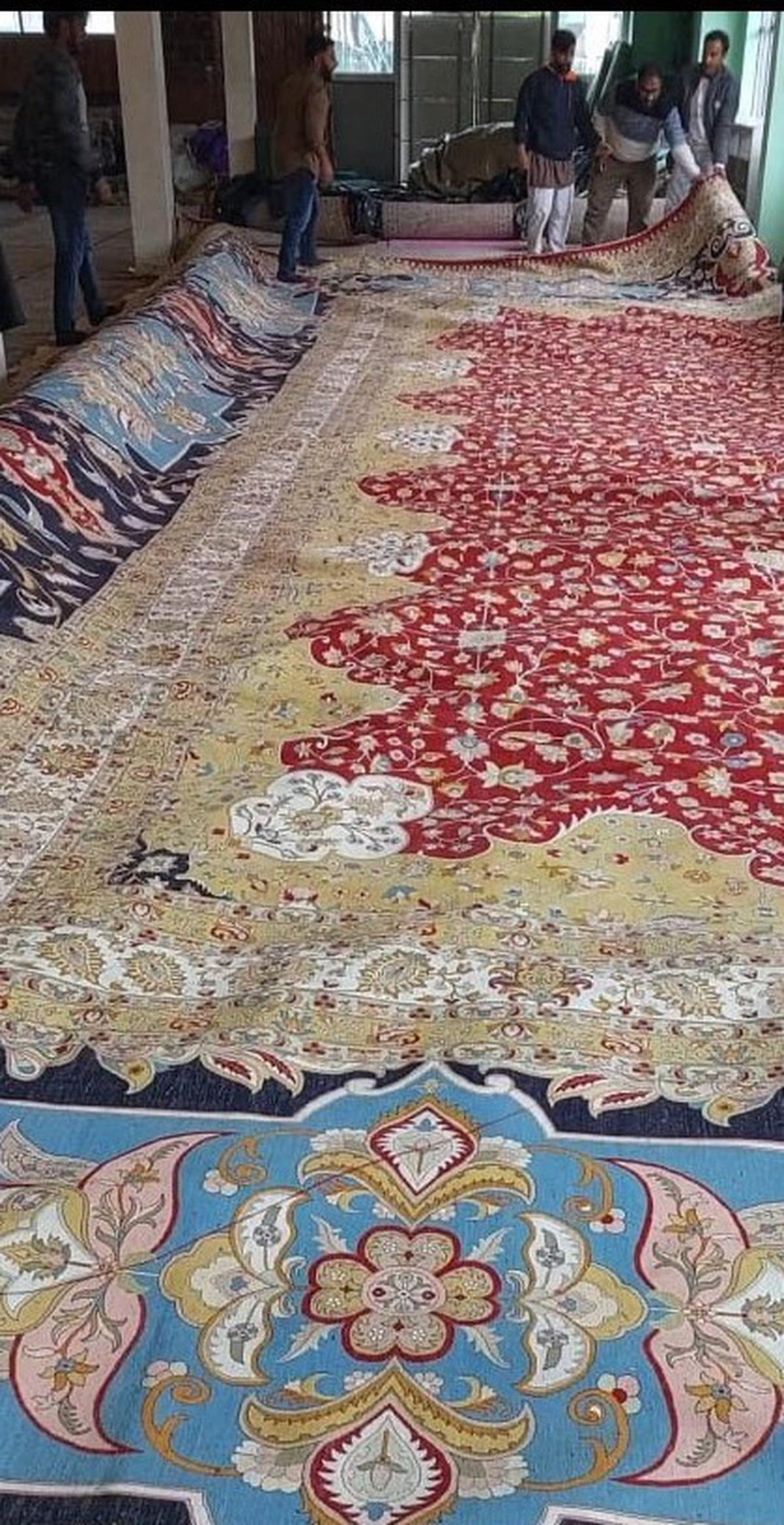Kashmir’s Magic Carpet | 23 Apr 2024
Why in News?
Recently, the famous Hazratbal Dargah in Srinagar is attracting locals for a rare spectacle of the washing and clipping of the largest carpet woven in Kashmir so far.
What is Kashmir's Magic Carpet?
- About:
- Kashmir’s magic carpet made in Kashan Style is an intricate marvel, 72 feet in length and 40 feet in width, weighing 1,685 kg, and featuring over three crore knots.
- It has taken eight years to weave, with artisans returning to the traditional trade and overcoming several challenges including the 2014 floods, the abrogation of Article 370 in Jammu and Kashmir in 2019, and the waves of the Covid-19 pandemic.
- At least 30 people are required to unroll this mammoth carpet.
- A dedicated team of 30-35 professional washers diligently tends to it on a daily basis.
- It is likely to embellish a palace in the Middle East.
- Kashmiri artisans are competing for the first time against their long-standing Iranian competitor, who have crafted a carpet the size of a soccer field at 60,468 square feet.
- Kashan Style:
- The carpet follows the Kashan style, a historic design borrowed from the Iranian city of Kashan.
- The Kashan style of ceramic art, originating from the historic city of Kashan in Persia (modern-day Iran), has captivated art enthusiasts for centuries.
- Known for its exquisite execution and intricate patterns, Kashan ware represents a harmonious blend of tradition, innovation, and artistic finesse.
- Historical Context:
- Legacy of Zain-ul-Abidin: The carpet craft traces its roots back to the 15th century when Badshah Zain-ul-Abidin invited artisans from Persia and Central Asia to settle in Kashmir.
- From Shawls to Carpets: Initially, the focus was on weaving exquisite pashmina shawls. However, with the decline of demand due to jacquard looms in Europe, artisans shifted their skills to carpet weaving.
- British Recognition: Kashmiri carpets gained global acclaim after being exhibited at the Great London Exhibition of 1851.
- Prizes and Distinction: These carpets continued to shine at exhibitions in Chicago, Paris, and London during the late 19th and early 20th centuries.
- Weaving Secrets: The secret blueprints, known as talim, guide artisans across generations, preserving the ancient techniques.
Government Initiatives for Empowering Kashmir’s Carpet Weavers:
- Revival of Namda Craft under PMKVY 3.0:
- Objective: The Ministry of Skill Development and Entrepreneurship (MSDE) launched a special pilot project under the Pradhan Mantri Kaushal Vikas Yojana (PMKVY) to revive the traditional Namda craft of Kashmir.
- Namda Craft: Namda is a unique rug made of sheep wool using the felting technique instead of the normal weaving process.
- Recognition of Prior Learning (RPL) for Artisans and Weavers:
- The RPL component of PMKVY focuses on upskilling artisans and weavers.
- The initiative aims to upskill 10,900 artisans and weavers in Jammu and Kashmir.
- By enhancing productivity through RPL assessment and certification, the project ensures the continuation of Kashmir’s weaving legacy.
- Geographical Indication (GI) Tag for Kashmiri Carpets:
- GI Registry: The Jammu and Kashmir government initiated a Geographical Indication (GI) registry for the famed Kashmiri carpet.
- QR Code: Each GI-tagged carpet now comes with a quick response (QR) code, providing details of artisans and materials used.
- Export: The first consignment of GI-tagged carpets was exported to Germany, marking a significant step in safeguarding this craft.
UPSC Civil Services Examination, Previous Year Questions (PYQs)
Prelims:
Q. Which of the following has/have been accorded ‘Geographical Indication’ status? (2015)
- Banaras Brocades and Sarees
- Rajasthani Daal-Bati-Churma
- Tirupathi Laddu
Select the correct answer using the code given below:
(a) 1 only
(b) 2 and 3 only
(c) 1 and 3 only
(d) 1, 2 and 3
Ans: (c)
Q. Consider the following pairs: (2009)
| Tradition | State | |
| 1. | Gatka, a traditional : martial art | Kerala |
| 2. | Madhubani, a : traditional painting | Bihar |
| 3. | Singhey Khababs : Sindhu Darshan Festival | Jammu and Kashmir |
Which of the pairs given above is/are correctly matched?
(a) 1 and 2 only
(b) 3 only
(c) 2 and 3 only
(d) 1, 2 and 3
Ans: (c)

